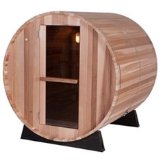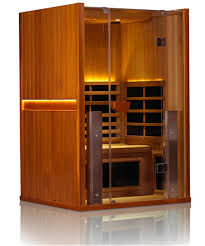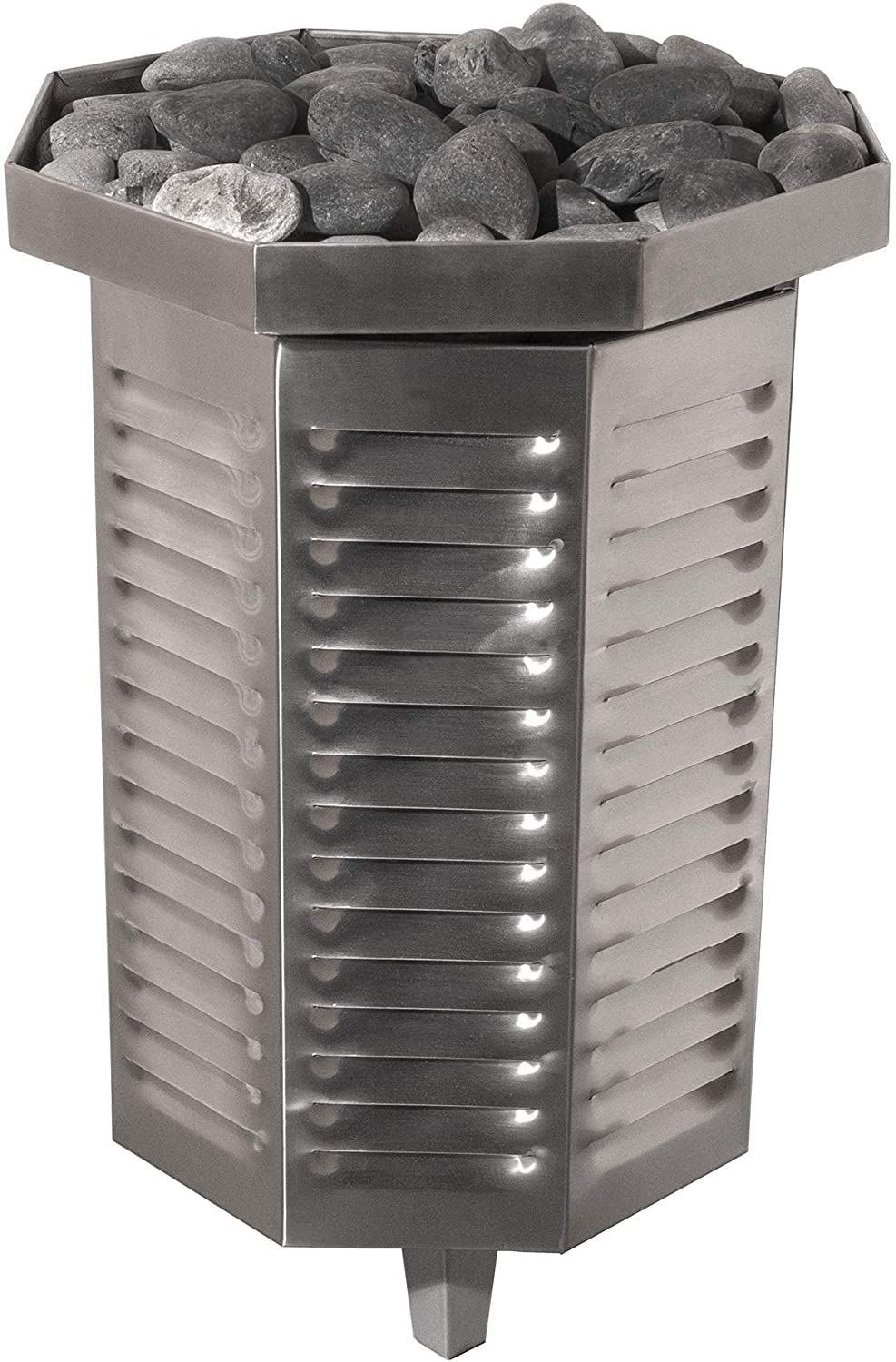
Gas Sauna Stove - How Does it Compare to Electric Heaters?
Gas is probably the most underrated sauna heater choice, but it is cleaner, more efficient and more affordable in the long run than almost any other heating option. That’s why, as with home heating, so many people opt to go with gas for their sauna rather than electric.
There are two types of gas sauna heaters: natural gas and propane.
Propane heaters can be attached to a tank on the outside of the sauna, which makes them a great option for mobile or remote saunas. Natural gas heaters are connected directly to your home’s gas line which makes them convenient and cost effective for indoor saunas or saunas directly adjacent to your house.
Gas heaters have a higher upfront cost, but the operational and maintenance cost is far less than it is for electric heaters. They function much the same as a gas stove in your kitchen, with either a pilot light or piezo ignition.
Pilot lights are manually lit using a match or lighter while a piezo ignites automatically using an electric charge. They generally take anywhere from 30-60 minutes to heat the room to temperature. The heat can be vented either horizontally or vertically to accommodate any type of sauna design.
Installing the Gas Sauna Heater
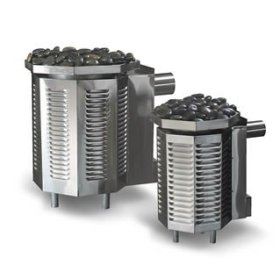
Because a gas heater must be connected to your home’s gas line, you’ll need to have a licensed HVAC professional install a gas line to the sauna and hook up the gas stove. This is a must, as your warranty may be voided if the gas sauna stove is not installed correctly.
The contractor will determine the proper size of pipe for adequate gas flow and will measure the distance to the sauna heater from the source, as well as take into consideration the BTU requirement of the heater.
The necessary BTU’s for your sauna are determined by measuring the length, width and height of the room and multiplying those numbers to derive the volume of the room in cubic feet. From this information, the contractor will be able to determine the proper heater for the room and also set the amount of the gas pressure that runs to the sauna gas heater.
Here are a few safety tips for installing a gas burning sauna stove:
- Check regulations regarding clearances from the sauna heater to the ceiling and walls.
- The room must have noncombustible floor and walls.
- The sauna stove must be connected to its own dedicated flue system.
- The heater must have a draft diverter installed above the gas stove on the flue pipe.
- Gas heaters need an external air intake separate from the ventilation system used to circulate air for breathing and heat.
- The stove’s gas and temperature controls must be located and operated from outside the sauna room.
- Power outlets cannot be installed in the sauna room.
Get the popular Torch gas heaters on sale now!
Using Your Gas Sauna Heater
Once installed, the contractor will run the heater for the first time for you. Before you use your gas sauna stove for the first bathing session, you’ll need to let it run for 30 minutes to allow the paint on the heater to cure.
Should you need to relight the pilot light on a sauna gas heater yourself at a later time, it’s no different than lighting the pilot light on your gas fireplace. Here are the steps to relight your heater (always follow the safety and lighting instructions that come with your particular sauna stove):
- Turn off all electric power to the heater.
- Partially depress the control knob and turn it clockwise past “Pilot” to the “Off” position.
- Wait 5 minutes to allow any remaining gas in the sauna stove’s combustion chamber to escape. Go to the next step only if you don’t smell gas.
- Turn the gas stove’s control knob back to “Pilot” position.
- Ignite the pilot with the push button igniter while depressing the gas control knob fully. Once it lights, continue pushing in the knob for another 5 seconds. If the sauna heater stays lit, release the gas control knob.
- Turn the sauna heater’s control knob counter-clockwise to the “On” position.
With your gas sauna heater properly installed, you’ll be able to enjoy a softer, more comfortable heat than you would with electric heaters for the closest thing you can get to the natural sauna feel. Your gas sauna heater will be outfitted with a stone tray that you can you can use to produce steam for added health benefits.
The contractor will determine the proper size of pipe for adequate gas flow and will measure the distance to the sauna heater from the source, as well as take into consideration the BTU requirement of the heater. From this information, the contractor will also set the amount of the gas pressure that runs to the sauna gas heater.
Here are a few safety tips for installing a gas burning sauna stove:
- Check regulations regarding clearances from the sauna heater to the ceiling and walls.
- The room must have noncombustible floor and walls.
- The sauna stove must be connected to its own dedicated flue system.
- The heater must have a draft diverter installed above the gas stove on the flue pipe.
- Gas heaters need an external air intake separate from the ventilation system used to circulate air for breathing and heat.
- The stove’s gas and temperature controls must be located and operated from outside the sauna room.
- Power outlets can not be installed in the sauna room.
Firing Up the Sauna Gas Stove
Once installed, the contractor will run the heater for the first time for you. Before you use your gas sauna stove for the first bathing session, you’ll need to let it run for 30 minutes to allow the paint on the heater to cure.
Should you need to relight the pilot light on a sauna gas heater yourself at a later time, it’s no different than lighting the pilot light on your gas fireplace. Here are the steps to relight your heater (always follow the safety and lighting instructions that come with your particular sauna stove):
- Turn off all electric power to the heater.
- Partially depress the control knob and turn it clockwise past “Pilot” to the “Off” position.
- Wait 5 minutes to allow any remaining gas in the sauna stove’s combustion chamber to escape. Go to the next step only if you don’t smell gas.
- Turn the gas stove’s control knob back to “Pilot” position.
- Ignite the pilot with the push button igniter while depressing the gas control knob fully. Once it lights, continue pushing in the knob for another 5 seconds. If the sauna heater stays lit, release the gas control knob.
- Turn the sauna heater’s control knob counter-clockwise to the “On” position.
With your gas sauna heater properly installed, you’ll be able to enjoy a softer, more comfortable heat than you would with electric heaters for the closest thing you can get to the natural sauna feel. Your gas sauna heater will be outfitted with a stone tray that you can you can use to produce steam for added health benefits.
What Are the Best Gas Sauna Heaters?

Torch TS-60 and TS-80 Propane/Gas Sauna Heaters
When it comes to gas sauna heaters, Torch is one of the best brands out there.
Torch gas sauna heaters come in 2 sizes, the TS-60F (60,000 BTU's) and TS-80F (80,000 BTU's). Torch Gas Sauna heaters can be ordered to either use Propane Gas (LP) or Natural gas.
The Torch TS-60F gas sauna heater will heat a properly insulated sauna as big as 500 cubic ft.
The Torch TS-80F gas sauna heater will heat a properly insulated sauna over 500 cubic feet.
One of the best parts about Torch sauna heaters is that there is no electricity required. They have a standing pilot and they have temperature and timer controls.
Compared to other heaters on the market it is quick to heat up, which makes it a great choice. Plus, shipping is free in the US!
(mention Sauna Talk for 50% off a thermometer with any heater purchase)
Scandi-Vico is another good option. They have been building the world’s best sauna heaters since 1964 and currently have several models available, all constructed with Scandia-Vico’s high quality standards.
Scandia-Vico 240/280 Gas Sauna Heaters
Both models of Scandia-Vico gas sauna heaters are floor mounted and constructed of 100% 321 Spec Stainless Steel, the same materials used in jet engine after burners. They are sealed combustion heaters that require no gas or flue connections inside the sauna itself. The solid rock tray is the largest in the industry, designed to hold up to 160 lbs. of high-density rocks, which are included with your purchase.
They also feature an eight gallon water capacity allowing for maximum steam effects. The two models differ according to their BTU capabilities, with the 240 having a 40 BTU limit and measuring 30” x 30” while the 280 has an 80 BTU limit and measures slightly larger at 40.5” x 42”. Both units come with either a pilot light or piezo ignition system and can be vented either horizontally or vertically depending on the design of your sauna. Each model comes with a draft hood for vertical venting or a flue cap for direct venting.
They can heat up to a 616 cubic foot room and come with “G” wall controls with a standard 60 minute or 24 hour timer and a mechanical thermostat to protect against overheating. It retails at about $3,150 with the pilot light or $3,350 with the piezo ignition.
Infrared Saunas
Sauna Heaters
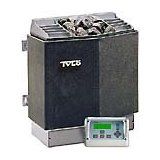
How to Install a Wood Sauna Heater
Sauna Kits
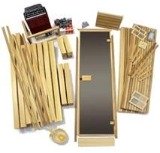
Buying Guide
